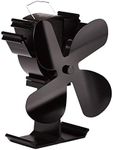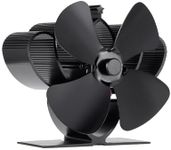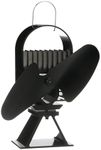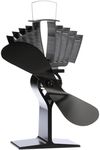Buying Guide for the Best Stove Fans
Choosing the right stove fan can significantly enhance the efficiency of your wood-burning stove by distributing heat more evenly throughout your space. When selecting a stove fan, it's important to consider several key specifications to ensure you get the best fit for your needs. Understanding these specs will help you make an informed decision and maximize the benefits of your stove fan.MaterialThe material of the stove fan is crucial for durability and heat resistance. Common materials include aluminum, steel, and sometimes ceramic. Aluminum is lightweight and resistant to rust, making it a good choice for longevity. Steel is robust and can withstand higher temperatures, but it may be heavier. Ceramic is less common but offers excellent heat resistance. Choose a material that matches your stove's heat output and your preference for durability.
SizeThe size of the stove fan affects its ability to circulate air effectively. Smaller fans are suitable for compact spaces and smaller stoves, while larger fans can move more air and are better for bigger rooms and larger stoves. Consider the size of your stove and the area you want to heat when selecting the fan size. A fan that is too small may not distribute heat efficiently, while a fan that is too large may be unnecessary for a small space.
Blade DesignBlade design impacts the airflow and efficiency of the stove fan. Fans with more blades or specially designed blades can move air more effectively. Look for designs that promise quiet operation and efficient air circulation. If you have a larger space or need more robust air movement, opt for fans with advanced blade designs. For smaller areas, simpler blade designs may suffice.
Operating Temperature RangeThe operating temperature range indicates the temperatures at which the fan can function optimally. This is important because it ensures the fan will work effectively with your stove's heat output. Fans typically have a minimum and maximum operating temperature. Ensure the fan you choose can operate within the temperature range of your stove to avoid damage and ensure efficient performance.
Noise LevelNoise level is an important consideration for comfort. Some stove fans operate very quietly, while others may produce noticeable noise. If you prefer a quiet environment, look for fans specifically designed for low noise operation. For those who don't mind a bit of noise or have a noisy environment already, this may be less of a concern. Always check user reviews for real-world noise levels.
Power SourceStove fans can be powered by electricity or thermoelectric technology. Thermoelectric fans generate power from the heat of the stove, making them energy-efficient and convenient as they don't require external power. Electric fans may offer more consistent performance but require a power source. Choose a power source that aligns with your preference for convenience and energy efficiency.














